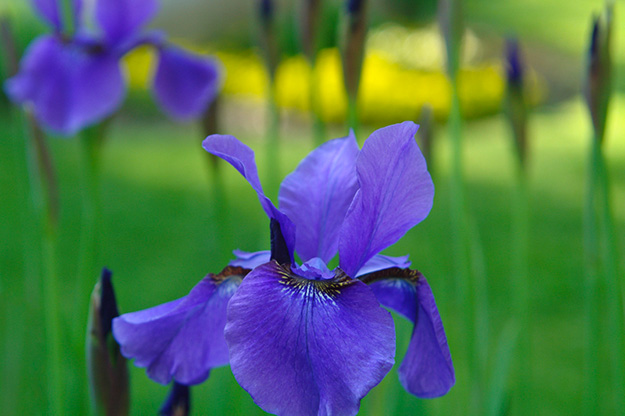
I would like to share a photographic project with you: exploring my garden. “One Garden, one Camera, one Year” was the original idea. I started pursuing it after I took some initial pictures and got excited. Now the one year turned into more than three years, but the limitation on one small garden and one camera stayed.
One garden – boring, you think?Well, not necessarily. I admit my garden is small. And if you walked by my house, you would not get wowed to rush for your camera. As much as I like my garden, it is not readily posing to attract photographers. But this is one of the rewarding experiences of my garden photo project: if you come with open eyes, if you look closer and take your time, there is plenty to discover in my garden – and I am now convinced, anywhere else too.
One camera (with a fixed lens even) – limiting, you think?Well, maybe somewhat. But the lens is a zoom lens, and a superb one for that matter. The camera is a Sony R1, and it is equipped with a magnificent Zeiss lens. I learned to appreciate it greatly. The lens reaches from 24mm to 120mm (35mm equivalent). Wide enough to capture our large trees, and while not long enough to chase the squirrels and birds in the backyard, it gives comfortable access to close-ups of leaves and flowers with its magnification ratio of 1:4. Most of the pictures I actually took in one of the extreme settings – either at the wide angle end to cover larger scenery (with the aperture stopped down to f/5.6-f/11) or at the tele end for close-ups (with the aperture wide open at f/4.8).
Let me share with you a selection of the garden pictures. I arranged most of them in pairs with a common theme.
Looking ahead – trees.We live in a wooded area. Our property’s footprint is small, only one third of an acre. But it certainly looks tall! The backyard is dominated by several large trees, more than twice the height of our two-story house. You get an impression from the first two pictures, one taken in summer (or more precisely, shortly after summer), the other one in winter. The winter trees are actually located on our neighbor’s property across the front street. And the background trees in the summer picture are growing on the lot that borders our backyard. I am mentioning this to clarify my “one garden“ rule: I have been limiting myself not to pictures of my garden, but to pictures from my garden. As long as I stood on my own property, everything in sight was fair game for the camera.
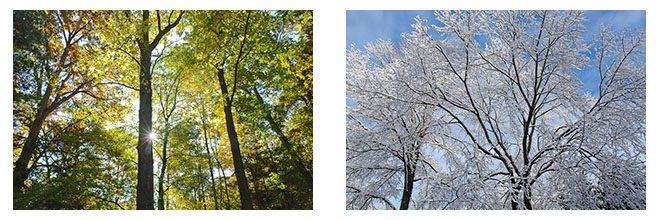
October 2008
Looking up – more trees. Here are two more tree pictures, now looking upward. The spring picture is one of my favorites. I like how the new leaves glow in the sun like stars in the sky. The fall picture is also special for me as I had only very few opportunities to take pictures in foggy weather. An important element in both pictures is the layering of the leaves. The larger leaves in the foreground add their own texture and interest to the photos, and together with the smaller leaves further back they help create the impression of depth.
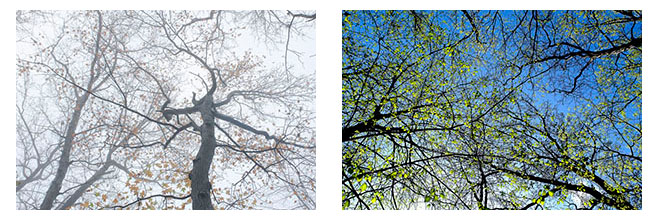
Looking down – ground cover. Now looking straight down to the ground vegetation. It basically appears as a flat tapestry in these examples. With no parallax between foreground and background, it comes down to finding an interesting pattern and framing it well. I know that these two photos are not special. Probably thousands of photos that show leaves on the ground have been made before. But to paraphrase Michael Reichmann: it may have been done before – but not by me. And let me add: … and not in my garden. If I would aim to take only pictures that have never been done before, it would be a sure set-up for failure and disappointment. Important for me was that I find pictures that I really like, that I can connect to. And actually doing them in my backyard. Then they become my own. And the leave picture reminds me of the oak and sweet gum trees that populate our backyard.
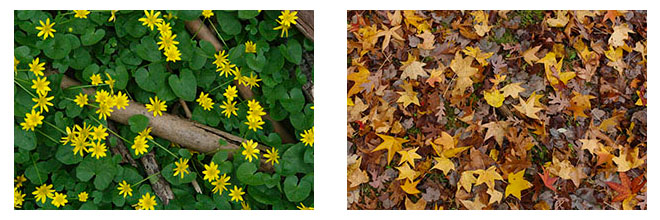
Kneeling down – flowers. Moving the camera close to the ground, the smaller plants now show up in layered views. The different layers have to fit together for a good composition, and small changes in the camera position have drastic effects on the final image. Camera positioning and framing become more demanding. I learned to appreciate the tilted LCD screen, which is nicely viewable from above. I do not want to be without such a screen anymore. For the photo of the lily of the valley, the camera was positioned directly on the ground – there was no way to look through the viewfinder. And I learned to love the lens’ rendering of out-of-focus layers. I routinely used its long end (120mm equivalent) at the widest aperture (f/4.8) for close-ups, and even though f/4.8 is by no means a wide aperture, it does create a very lovely texture with the right objects. The leaves on the right hand side of the lily of the valley image are rendered with this beautiful painterly quality.
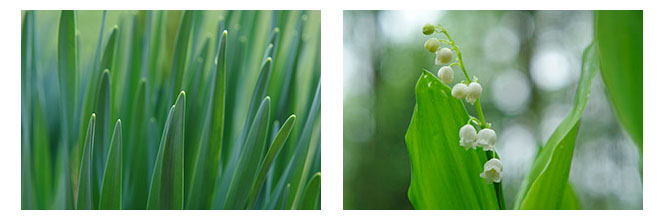
Looking for color and simplicity– bushes. In winter, many colors in the vegetation have faded away. Not so on our rose bush. While all its green leaves are gone, red rose hips are still clinging on. In the picture, snow on the ground provides a clean background, and makes the red fruit on the little branch stand out in a simple and sparse composition. In spring, our forsythia bushes are one of the first plants to bring back color with their yellow blossoms. For the photo, I was leaning into the forsythia bush. Overexposure against the bright sky made the petals appear translucent. Overexposure was also effective in cleaning up the background (which was quite crowded actually). I like the luminous effect one can achieve with this inside-out perspective in bushes and trees, and I have been seeking it out more often lately.
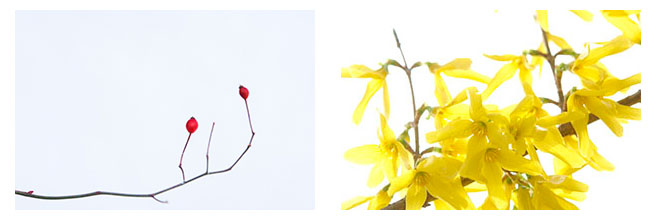
Finding figures– eye in the sky, eye in the tree. I like to find figures in nature. The roots of one of our trees have a shape that resembles an alligator head. The young branches of a bush at our fence appear as little persons with raised arms. Here are two images that both include the shape of an eye, each with a similar slit. And yet they are very different – a fleeting cloud in the sky and the bark of a hickory tree. The cloud lasted only for a few seconds, then its shape was gone and would never return. And the bark, in contrast, is solid and lasting. It may actually be the only object that I photographed in the three years where I could go back and take its picture again with pretty much the same result.
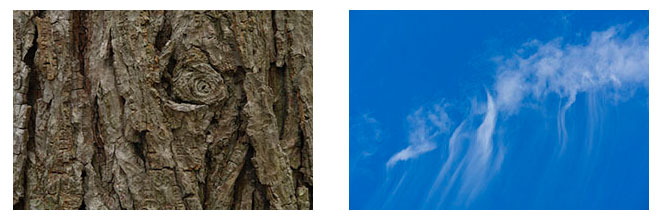
Feeling the elements– water. Whenever I see heavy rain, I would love to capture it in a photo. We had gorgeous cloud bursts, yet I have not been able to take any picture that does justice to the elemental feeling of a downpour. I had to be content with showing the after-effect – the water on the plants. The photo of the bush is one such after-rain image. It evokes a strong sense of wetness. The water is very visible. It reflects the brightness of the sky and makes the wet leaves shiny. My filter on the lens had caught some rain drops. These acted as diffusers and contributed further to the feeling of wetness in the image.The iris leaves, in contrast, handle the rain in a very different way. They do not simply get wet. They turn the water into pearls and create a more elegant and ornamental picture with a very different feel.
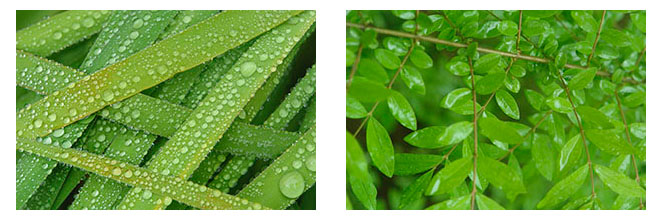
Variations on a theme– lavender. Our garden is constantly changing. The trees, the bushes, the flowers, all go through cycles. They provide interesting views at different stages and with different perspectives. The first lavender photo is taken in early June, most of the blossoms have emerged but are still closed. Later in June, the blossoms open and the bees come to visit. The bees are constantly in motion then. I took (very!) many photos where the bees were either out of focus or had already moved away from the spot where I wanted them to appear. So I am especially happy how this second photo worked out – with its combination of bee and magical background. I truly love the rendering of the lens.
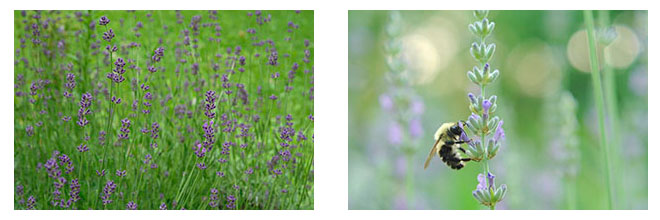
Cropping to other image formats– azalea. I started cropping the photos individually, without a predetermined format. They would end up slightly higher, slightly wider, with varying aspect ratios yet usually not far off from the original. This may well have benefited them individually, though as a whole, the photos did not feel like a consistent series. So I changed the approach. I still used cropping as an editing tool, but now I stuck to the 2:3 format for photos in landscape orientation. The images appeared more strongly connected this way. Of course, there are exceptions to this rule. The following azalea picture is one example. We have several beautiful azalea bushes in our yard. But as beautiful as they are to look at, as difficult they are to photograph. They look good from farther away, but do not have a surrounding that recommends them for a photo from that distance. And getting closer to the gorgeous abundance of flowers makes imperfections show up. Blossoms may be torn, have spots or other marks, and the wooden stems and green leaves of the azalea branches may show up in dissonance with the soft flow of the flowers. Below is my favorite azalea picture so far. It has the texture and light that I had in mind and was trying to show in the photo. And it works well in the panoramic format crop. (And yet, I am still trying for an azalea picture that fills a full 2:3 frame.)
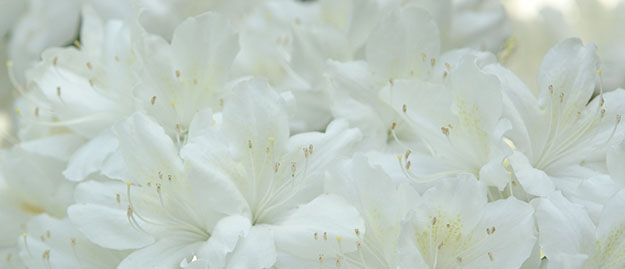
Appreciating the less glamorous– weeds on the fence. When the azaleas are blooming, they do draw attention. Take our picture, we are so pretty! Other plants in the garden pose in a much less obvious way. And I find it particularly rewarding to find beauty in places that can easily be overlooked. The photo of the winding weeds on our fence is one of my favorite pictures in that category.
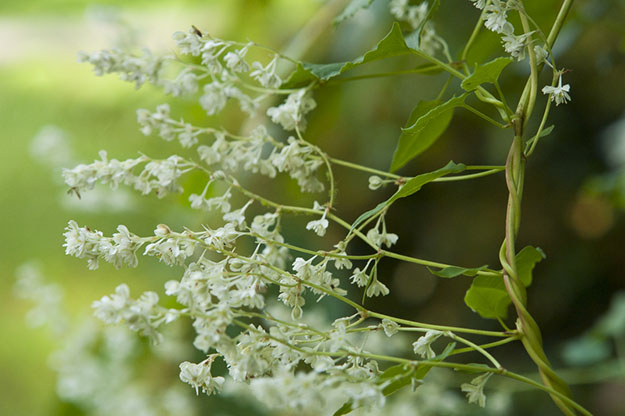
For me, photography is about discovery. And I discovered sights and images that were much more diverse and interesting than I had thought in the beginning – all within the confines of my small garden. It turned out to be perfectly fine not to venture outside. I learned to have the confidence that there is always something interesting to be found. And if that is true in my garden, it will hold true for anywhere else – at least nearly always.
With this confidence, though, comes also a great humbleness. I do not create. I only discover, I find. There is always a portion of luck. These are natural scenes. I am not in control. There is no good image if object and background and lighting do not come together. And these are ever changing. I have learned to appreciate the fleeting nature of the surrounding. Whenever I had taken a picture that I liked a lot but that suffered from some flaw like incorrect focus, I did try to go back and take the same picture again. I never succeeded, though. It always turned out to become a new, different picture. Sometimes I liked the result. Many times I did not. We better celebrate the moment and the uniqueness of each picture.
Ultimately, the limitations of one camera and of one location were a blessing. They brought a peace of mind: I did not feel like missing out on anything beyond. I was meant to explore my own garden with this camera. Nothing more for now. It was here where the treasures were to be found, and I had all the time to concentrate on it. And I did take my time to approach each picture, actually more and more with my increasing awareness of how much even little details matter for the final result. Photography can become like meditation, with the reward of finding special (in)sights in the regular surroundings.
Let me mention one technical aspect – I would like to give praise to my monopod. The monopod became an essential tool. Not only to keep the camera steady and allow for longer exposures. But to explore a variation of camera poses around a main “anchor” view. While a tripod is too static, and purely handheld operation misses a repeatable anchor, the monopod has a good balance between flexibility and repeatability. Have you ever worked on close-ups of leaves and flowers and then – there came the wind? You know that it really does not take much wind to stop you in your tracks, whereas it does take a lot of patience to wait for the short breaks when it is still for a moment. Now you can’t just freeze in your position and stand there waiting without motion (at least I can’t), but keeping the monopod in place you can quickly find back to your anchor position and capture a few shots around it. The monopod is your friend.
So why did I do this project? Why do I spend my time taking pictures? The answer is ultimately simple: because I can, and because I like it. It feels good to explore, and it feels great to come up with photos that I can connect to and that are special for myself. I think there is a creative impulse in us. We draw inner satisfaction from exercising creativity. When photographing other people in the street, the why question can become much more nagging. Who am I that I take their photos, do I do them justice? Taking pictures in my own garden: why not? It is poetry, not documentation. It’s fun. It’s rewarding. It’s human.
After a bit more than three years, I have closed the project in 2011. Not because I wanted to stop taking pictures in my garden. But because I retired the R1. I acquired a new camera and several lenses, amongst them a beautiful macro lens. Photography is still going on, now with the new equipment – both in the garden and also beyond.
Frank Sauer has been taking photos nearly all of his life. He feels that the practice of creativity is an essential ingredient of happiness.
You can see some more of his pictures at franksauer.smugmug.com.







